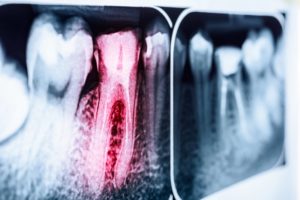
When you go in for your routine dental checkup, one of the dentist’s team members takes digital X-rays of your teeth. Later, while performing your comprehensive exam, the dentist looks at your X-rays. But do you know why your dentist uses this advanced technology? What do X-rays show your dentist in Midland that they can’t see on their own? In this post, you’ll learn about four examples of the kinds of things your dentist looks for in your X-rays and how they can use that information to keep your smile happy and healthy.
Extent of Tooth Decay
In many cases, your dentist can easily spot cavities on your teeth without the aid of any special tools. However, your X-rays can reveal just how deep the decay goes into your tooth, helping the dentist determine whether a normal filling or more extensive (i.e., a root canal) treatment will be needed to resolve the problem. In addition, some areas of your mouth, such as in between your teeth, are not easy to inspect with the naked eye. X-rays allow your dentist to check these areas for cavities and catch them before they progress into more serious, painful problems down the road.
Development of Wisdom Teeth
Typically, between the ages of 16 and 21, your third molars, commonly called wisdom teeth, start to emerge. In some cases, these teeth can develop at an odd angle or cause problems even before they erupt through the gums. With digital X-rays, your dentist can keep a close eye on these teeth. If your dentist determines that your wisdom teeth will likely cause alignment problems, oral infections, or other issues, they can plan to extract these teeth early on, saving your smile from any unnecessary complications.
Infections below the Gums
As with any other part of the body, your teeth and gums can develop infections, some of which occur below the gums’ surface. For example, an abscess or a pus-filled pocket can form at the tip of your tooth’s root. Although it often results in swelling in the gums, X-rays can reveal exactly where and how bad the infection is, allowing your dentist to address the infection with a root canal before it spreads to other areas of your face, neck, or head.
Problems with Other Oral Structures
In addition to your teeth, X-rays show your jaw bone. Your dentist can find out about its health and density, which comes in handy for complicated procedures, such as implant placement. Although more advanced technology, such as a cone beam CT scanner, can provide more detailed information, X-rays are a great place to start gathering this important data.
In the end, these X-rays play a critical role in helping you maintain your healthy smile. Without them, you may experience more severe and painful future oral problems with lasting consequences. Luckily, you have this technology at your disposal. Just make sure that you continue going to the dentist for your checkup and cleaning every six months!
About the Practice
At Boyles General Dentistry & Implant Center, patients in Midland, Texas, have access to not just one but three experienced, knowledgeable dentists. Dr. Stephen Boyles, Dr. Ken Etheredge, and Dr. Franklin Boyles each have years of dentistry experience and have equipped the practice with the most innovative technology available, including digital X-rays and a cone beam CT scanner. To learn more about the tools they use in the practice, contact their office by calling (432) 685-7011 or clicking here.